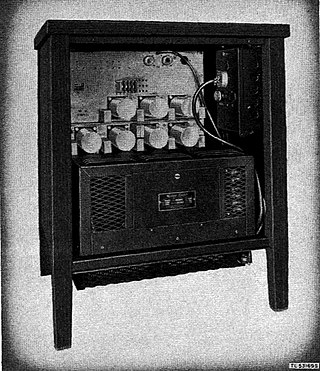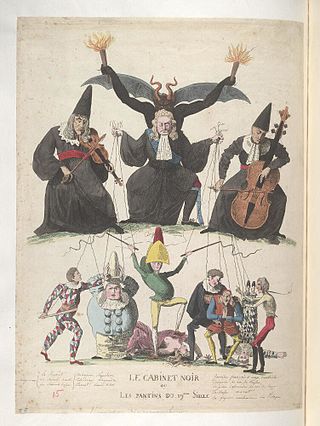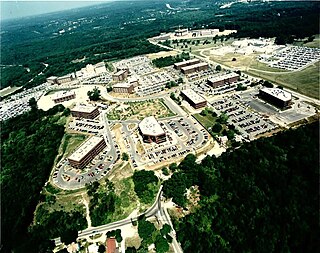Related Research Articles

ECHELON, originally a secret government code name, is a surveillance program operated by the five signatory states to the UKUSA Security Agreement: Australia, Canada, New Zealand, the United Kingdom and the United States, also known as the Five Eyes.

The National Security Agency (NSA) is a national-level intelligence agency of the United States Department of Defense, under the authority of the Director of National Intelligence (DNI). The NSA is responsible for global monitoring, collection, and processing of information and data for foreign and domestic intelligence and counterintelligence purposes, specializing in a discipline known as signals intelligence (SIGINT). The NSA is also tasked with the protection of U.S. communications networks and information systems. The NSA relies on a variety of measures to accomplish its mission, the majority of which are clandestine. The existence of the NSA was not revealed until 1975. The NSA has roughly 32,000 employees.
The Venona project was a United States counterintelligence program initiated during World War II by the United States Army's Signal Intelligence Service and later absorbed by the National Security Agency (NSA), that ran from February 1, 1943, until October 1, 1980. It was intended to decrypt messages transmitted by the intelligence agencies of the Soviet Union. Initiated when the Soviet Union was an ally of the US, the program continued during the Cold War, when the Soviet Union was considered an enemy.

TEMPEST is a U.S. National Security Agency specification and a NATO certification referring to spying on information systems through leaking emanations, including unintentional radio or electrical signals, sounds, and vibrations. TEMPEST covers both methods to spy upon others and how to shield equipment against such spying. The protection efforts are also known as emission security (EMSEC), which is a subset of communications security (COMSEC).

Herbert Osborn Yardley was an American cryptologist. He founded and led the cryptographic organization the Black Chamber. Under Yardley, the cryptanalysts of The American Black Chamber broke Japanese diplomatic codes and were able to furnish American negotiators with significant information during the Washington Naval Conference of 1921–1922. Recipient of the Distinguished Service Medal. He wrote The American Black Chamber (1931) about his experiences there. He later helped the Nationalists in China (1938–1940) to break Japanese codes. Following his work in China, Yardley worked briefly for the Canadian government, helping it set up a cryptological section of the National Research Council of Canada from June to December 1941. Yardley was reportedly let go due to pressure either from the Secretary of War Henry L. Stimson or from the British.

The Central Security Service (CSS) is a combat support agency of the United States Department of Defense which was established in 1972 to integrate the National Security Agency (NSA) and the Service Cryptologic Components (SCC) of the United States Armed Forces in the field of signals intelligence, cryptology, and information assurance at the tactical level. In 2002, the CSS had approximately 25,000 uniformed members. It is part of the United States Intelligence Community.

The National Cryptologic Museum (NCM) is an American museum of cryptologic history that is affiliated with the National Security Agency (NSA). The first public museum in the U.S. Intelligence Community, NCM is located in the former Colony Seven Motel, just two blocks from the NSA headquarters at Fort George G. Meade in Maryland. The motel was purchased, creating a buffer zone between the high security main buildings of the NSA and an adjacent highway. The museum opened to the public on December 16, 1993, and now hosts about 50,000 visitors annually from all over the world.

William Bolding Black Jr. is a former Deputy Director of the National Security Agency.
The Black Chamber (1919–1929), also known as the Cipher Bureau, was the United States' first peacetime cryptanalytic organization, and a forerunner of the National Security Agency. The only prior codes and cypher organizations maintained by the US government had been some intermittent, and always abandoned, attempts by Armed Forces branches prior to World War I.

The United Kingdom – United States of America Agreement is a multilateral agreement for cooperation in signals intelligence between Australia, Canada, New Zealand, the United Kingdom, and the United States. The alliance of intelligence operations is also known as the Five Eyes. In classification markings this is abbreviated as FVEY, with the individual countries being abbreviated as AUS, CAN, NZL, GBR, and USA, respectively.

NSA warrantless surveillance — also commonly referred to as "warrantless-wiretapping" or "-wiretaps" — refers to the surveillance of persons within the United States, including U.S. citizens, during the collection of notionally foreign intelligence by the National Security Agency (NSA) as part of the Terrorist Surveillance Program. In late 2001, the NSA was authorized to monitor, without obtaining a FISA warrant, phone calls, Internet activities, text messages and other forms of communication involving any party believed by the NSA to be outside the U.S., even if the other end of the communication lays within the U.S.

Hepting v. AT&T, 439 F.Supp.2d 974, was a class action lawsuit argued before the United States District Court for the Northern District of California, filed by Electronic Frontier Foundation (EFF) on behalf of customers of the telecommunications company AT&T. The plaintiffs alleged that AT&T permitted and assisted the National Security Agency (NSA) in unlawfully monitoring the personal communications of American citizens, including AT&T customers, whose communications were routed through AT&T's network.


In France, the cabinet noir was a government intelligence-gathering office, usually within a postal service, where correspondence between persons or entities was opened and read by government officials before being forwarded to its destination. However, this had to be done with some sophistication, as it was considered undesirable if the subjects of the practice knew about it, and important "that the black chamber not interrupt the smooth running of the postal service." This practice had been in vogue since the establishment of postal and telegraphy services, and was frequently used by the ministers of Louis XIII and Louis XIV; but it was not until the reign of Louis XV that a separate office for this purpose was created. This was called the cabinet du secret des postes, or more popularly the cabinet noir. Although declaimed against at the time of the French Revolution, it was used both by the revolutionary leaders and by Napoleon.

The Friendship Annex, also known as FANX or FANEX, is a National Security Agency (NSA) facility complex located in Linthicum, Maryland, near the Baltimore Washington International Airport (BWI). Established in the 1970s, the complex consists of multiple buildings and serves multiple roles as a cyber espionage station, electronic intelligence processing facility, and NSA Broadcast Network television studio. It is also the primary campus of the National Cryptologic School.

The practice of mass surveillance in the United States dates back to wartime monitoring and censorship of international communications from, to, or which passed through the United States. After the First and Second World Wars, mass surveillance continued throughout the Cold War period, via programs such as the Black Chamber and Project SHAMROCK. The formation and growth of federal law-enforcement and intelligence agencies such as the FBI, CIA, and NSA institutionalized surveillance used to also silence political dissent, as evidenced by COINTELPRO projects which targeted various organizations and individuals. During the Civil Rights Movement era, many individuals put under surveillance orders were first labelled as integrationists, then deemed subversive, and sometimes suspected to be supportive of the communist model of the United States' rival at the time, the Soviet Union. Other targeted individuals and groups included Native American activists, African American and Chicano liberation movement activists, and anti-war protesters.

Ongoing news reports in the international media have revealed operational details about the Anglophone cryptographic agencies' global surveillance of both foreign and domestic nationals. The reports mostly emanate from a cache of top secret documents leaked by ex-NSA contractor Edward Snowden, which he obtained whilst working for Booz Allen Hamilton, one of the largest contractors for defense and intelligence in the United States. In addition to a trove of U.S. federal documents, Snowden's cache reportedly contains thousands of Australian, British, Canadian and New Zealand intelligence files that he had accessed via the exclusive "Five Eyes" network. In June 2013, the first of Snowden's documents were published simultaneously by The Washington Post and The Guardian, attracting considerable public attention. The disclosure continued throughout 2013, and a small portion of the estimated full cache of documents was later published by other media outlets worldwide, most notably The New York Times, the Canadian Broadcasting Corporation, the Australian Broadcasting Corporation, Der Spiegel (Germany), O Globo (Brazil), Le Monde (France), L'espresso (Italy), NRC Handelsblad, Dagbladet (Norway), El País (Spain), and Sveriges Television (Sweden).

The origins of global surveillance can be traced back to the late 1940s, when the UKUSA Agreement was jointly enacted by the United Kingdom and the United States, whose close cooperation eventually culminated in the creation of the global surveillance network, code-named "ECHELON", in 1971.
The Hawaii Cryptologic Center (HCC) or NSA Hawaii is a U.S. National Security Agency (NSA) Central Security Service (CSS) facility located near Wahiawa on the island of Oahu, Hawaii. The facility opened on January 6, 2012, at a cost of $358 million. The center focuses on signals intelligence intercepts from Asia, and conducts cybersecurity and cyberwarfare operations.
Minnie M. Kenny was a cryptanalyst, educator and equal opportunity activist who worked at the National Security Agency (NSA). She served as deputy commandant at the National Cryptologic School and was responsible for creating scholarships for NSA employees. The recipient of numerous awards, including the Meritorious and the Exceptional Civilian Service Awards, the presidential Meritorious Executive Award and Distinguished Service Award of the CIA, Kenny was inducted into the Cryptologic Hall of Honor in 2009.
References
- ↑ "Black Chamber at espionageinfo". Archived from the original on 8 January 2010. Retrieved 4 December 2006.
- ↑ Kahn, David (13 January 2006). "Back When Spies Played by the Rules". The New York Times . Retrieved 21 May 2010.
London's was in Abchurch Lane, near St. Paul's. Black chambers resembled laboratories.
- ↑ Chisholm, Hugh, ed. (1911). . Encyclopædia Britannica . Vol. 4 (11th ed.). Cambridge University Press. p. 920.
- 1 2 Mark Klein (31 December 2005). "AT&T's Implementation of NSA Spying on American Citizens" (PDF). Wired. Archived from the original (PDF) on 3 June 2006.
- ↑ "National Security Agency Central Security Service > About Us > Cryptologic Heritage > Center for Cryptologic History > Pearl Harbor Review > The Black Chamber". www.nsa.gov. Retrieved 31 October 2020.